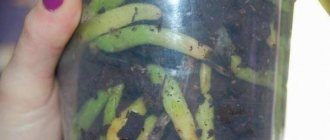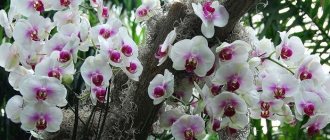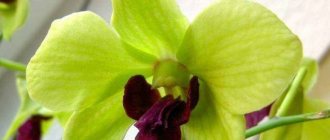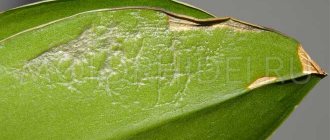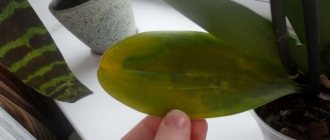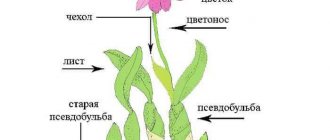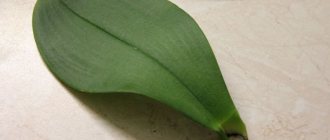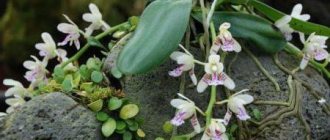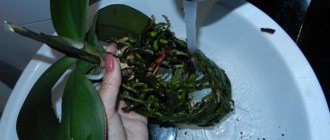With the arrival of spring, vitamin deficiency occurs, not only in people, but also in plants. A lack of sunlight leads to depletion of orchids , which is why it is so important to support them with additional feeding with vitamins.
A vitamin cocktail will help restore the orchid to its normal appearance. However, not all vitamins are suitable for plants. And how to use them correctly to achieve the best results, which recipe to choose - is written in this article.
Vitamin cocktail for orchids
Plants are living organisms just like humans. Naturally, for normal growth they need organic compounds such as vitamins . They contribute to better absorption of microelements, the development of the orchid, its health and, as a result, more confident and lush flowering. Some vitamins help retain moisture in plant tissues, which helps them adapt better and faster to new or changing conditions.
Features of application
Feeding with vitamins is usually similar to “feeding” a person. Vitamins are used during crises, light deficits, exhaustion or illness.
Recovery of an orchid can be quite slow after the use of pesticides; vitamins help neutralize the negative substances of chemical treatments. Vitamins can somehow stimulate systems in a plant, activating certain functions.
Hypervitaminosis
When using vitamin supplements, you need to be very scrupulous about dosages and timing of application. The fact is that with an excess of these substances, plants begin to develop hypervitaminosis, which very quickly leads to the opposite effect: at first the flower grows actively and seems healthy, but soon the growth stops and then stops altogether. If you continue to inject such solutions, the specimen may die. Visual manifestations of hypervitaminosis may include brown spots on the leaves near the midrib.
To prevent such developments, inexperienced flower growers are advised to give preference to ready-made preparations, which are diluted in accordance with the instructions on the package or bottle.
Vitamins needed for healthy growth and flowering
Vitamins for orchids at home are used for feeding purposes, as they are extremely important for the normal course of life processes. The prices for vitamins are usually cheap, but the benefits from them are tangible. The list includes the following vitamins: B1, B3 (PP), B6, B12, C.
IN 1
B1 or thiamine is an organic, water-soluble vitamin , is a colorless crystalline substance that is synthesized by plants themselves. However, under unfavorable (apartment) growth conditions, it can be synthesized in insufficient quantities, so periodic feeding is necessary.
The vitamin promotes more active functioning of the vascular system. And the orchid’s root system responds well to thiamine and begins to grow. Flowers appear earlier and are somewhat larger. Excess vitamins are eliminated well and quickly and do not accumulate, but they should not be abused.
Vitamin B1 promotes good growth of the root system.
AT 3
B3 (niacin, nicotinic acid or nicotine) . Usually white crystalline powder, odorless. Participates in redox reactions in living cells and is involved in hormonal metabolism.
The use of nicotinic acid will help the orchid recover more quickly after a transplant or illness . Accelerates the formation of flowers and children on the plant. It is a mandatory substance for use during the resuscitation of orchids.
B3 (niacin) is used in the resuscitation of orchids.
It is very stable and can be mixed with other compounds to achieve maximum results, but overdoses should be avoided. This vitamin should not be used on orchids more than once every 10 days.
AT 6
B6 or adermin are colorless crystals, highly soluble in water. It occurs in three forms (pyridoxine, pyridoxal, pyridoxyamine) . A very useful substance for orchids, as it can strengthen the plant’s immune system, thereby helping it during a pest attack or disease.
The use of fungicides or insecticides must certainly be accompanied by the addition of vitamin B6 - this will significantly speed up the recovery of the plant. Combines well with vitamin B3. Use no more than 3-4 times a month.
AT 12
Cobalamins are a group of cobalt-containing biologically active substances. The vitamin is synthesized exclusively by microorganisms, which is why feeding the orchid with this substance is so important. The substance can accelerate the growth rate of the plant, affect the formation of young or further development of old peduncles. B12 is extremely useful in the cold season with a lack of sunlight and fresh air.
WITH
Ascorbic acid or ascorbic acid is a general strengthening component for the plant. Can provide significant benefits in a cocktail. It has a positive effect on the plant’s immune system, improves respiration, and increases resistance to various parasitic insects and diseases.
Ascorbic acid has a general strengthening effect on orchids.
Advice! You can purchase any component of the vitamin cocktail at a regular pharmacy.
What is the importance of useful components?
All people are well aware that vitamins are simply necessary to improve overall health. If you think carefully, such complexes are necessary not only for people and animals, but also for many plants. Vitamins help improve all vital functions, so flowers will be no exception in this matter.
Decorative flowering plants need vitamin supplementation , because in this case they will grow faster and more intensively. All processes that are in one way or another associated with flowering require additional energy, so some complex groups of minerals and nutrients will be necessary.
ATTENTION : A lack of vitamins for orchids can result in anything. Flowers often lose their former beauty, because the leaves wither and turn yellow. If an orchid does not bloom for a long time, then this also indicates a lack of sufficient nutrients. Vitamin supplements can solve all the problems that have arisen and return the flowers to their former freshness.
Compositions for different occasions
Below you will find recipes for some vitamin cocktails and ways to prepare them at home:
- The composition of the cocktail for plant resuscitation and root growth is B1+B6+B12. Some sources recommend adding 4 tablets of succinic acid. Which is a rather controversial recommendation and therefore remains at the discretion of the grower. One ampoule of the vitamin is dissolved in a liter of water and added when watering. Vitamin B1 combines well with heteroauxin and greatly enhances its effect;
- composition recommended for feeding during the growing season – B1+B3. Apply approximately once every 2-4 weeks. It is better to use the spraying method with the addition of ascorbic acid. The dosage of vitamins is the same as in the first case - 1 ampoule per 1 liter of water. The most effective is spraying from a fine sprayer or spray bottle with an oblique stream from bottom to top. Try to ensure that the solution dust falls on the lower half of the sheet;
- composition for plant transplantation – B6 or B12 + a drop of zircon . This cocktail will help the plant quickly cope with the stress associated with replanting;
- composition with glucose for problems with turgor of leaves or pseudobulbs - glucose + B1 + B3. There is no specific treatment system for this composition. Approximately every 3-4 waterings.
Before making a vitamin cocktail, inquire about the compatibility of the vitamins included in it. You should know that they can destroy each other. B12 is incompatible with vitamins B1, B3, B6. In the presence of B6, B1 can be destroyed. But B3 and B6 work great together. Remember compatibility.
What nutrients does the plant need?
Flowers can obtain all their nutrients from moisture, air and the bark on which orchids often grow. It often happens that flowers lack those elements that come from these sources. This is when extra vitamins can help. Such feeding must be carried out with the onset of autumn, because then orchids cannot independently select useful elements for their own growth.
In order for orchids to grow harmoniously and bloom at the right time, it is necessary to include the following basic elements in their feeding:
- Nitrogen . This component is simply necessary for the plant to grow leaves. If its content is insignificant, the orchid will begin to lose its leaves and, as a result, will completely die. In spring, it is best to add fertilizers containing a high percentage of nitrogen.
- Potassium . This substance helps improve the process of photosynthesis. Among other things, it protects the plant from a variety of diseases and pests. It is best to add potassium to the fertilizer in the summer, because then the orchid is more susceptible to the influence of environmental factors.
- Phosphorus . An important element is responsible for the duration of flowering, so it is worth introducing just such a substance into fertilizers in the fall.
It is worth noting that it is necessary to add ascorbic acid to the fertilizer, because it helps strengthen the plant’s immunity. Group C elements protect the orchid from the harmful effects of ultraviolet radiation and also neutralize the effects of parasitic interference.
Preparation and shelf life
You can mix two or more vitamins. These substances dissolve in water. Water should be settled, at room temperature, up to 25 ° C, since vitamins are subject to decomposition when heated. You also need to understand that many water-soluble vitamins are quickly destroyed in sunlight . Therefore, the finished solution is not stored, but is used right there, on the spot.
For a cocktail, you can mix two or more vitamins.
Where to buy
All these drugs can be easily purchased without a prescription at any pharmacy. When purchasing, you can use the common name (for example, vitamin B12) or the pharmaceutical name (cobalamin). Vitamins for indoor flowers are sold in ampoules in liquid form or in tablets. It is more convenient to dilute solutions in liquid form, which makes them easier to dose.
Feeding methods
You can feed an orchid with vitamins in various ways. Typically, which method you choose depends on the conditions in which the orchid is located. And the effectiveness of processing depends on the method.
Therefore, to achieve the best result, the plant should be in the most comfortable conditions. Each method has its own advantages and disadvantages and is applicable in a given situation.
Spraying on leaves
Spraying is the most acceptable way to treat an orchid , since the vitamin goes directly to all organs of the plant and is used by the plant right there on the spot. You need to spray with a fine sprayer or spray bottle that produces a misty stream . Direct the stream from bottom to top, trying to get to the underside of the leaf, where the stomata are.
For spraying, use a spray bottle that produces a fine mist.
Advice! It is advisable to spray in the evening or before dawn, in good weather. If the temperature is below 22 °C, then spraying is not carried out. Otherwise, it may cause mold, mildew, or rot on the plant.
Root
Usually carried out together with regular feeding with fertilizers , vitamins are used here as an additive. Ground orchids can be watered in this way, epiphytes can be soaked, and orchids that grow on blocks can be sprayed.
Soak
Soak one or more orchids in a suitable container - a flowerpot, basin or bathtub. If there is not enough liquid to treat the plant, then the plants can be placed in the same pot with a solution of vitamins one at a time. However, here you should be as confident as possible in plant hygiene, since there is a risk of transferring any spores or parasitic living organisms from one pot to another.
Soaking in a vitamin cocktail.
Soak in the solution for 15-30 minutes 2 times a month , after which the pot is removed and all the liquid is allowed to drain. Do not leave any remaining solution in the pot with the plant or in the tray.
Watering
Watering 1-2 times a month is perfect for terrestrial orchid species , since these plants use the most moisture-intensive of the orchid substrates. Watering is carried out from above, try to evenly moisten the entire body of the substrate, after which you should remove the drained remains of the solution from the pot or tray.
Attention! Watering as a method of treating epiphytic/lithophytic orchid species with a vitamin cocktail is ineffective.
Use at home
All nutrients should be supplied to the plant only when it needs it. Some people believe that the more vitamins there are, the better and faster the flower will grow. Of course, in reality everything is not so simple.
If the orchid receives too many vitamin supplements, a reverse reaction may begin. Plants will be trapped by beneficial elements, which can also lead to death. It is important to correctly calculate the dosage of vitamins and add them only when absolutely necessary .
You cannot feed orchids during their flowering period, because the fruiting function is neglected and does not require additional intervention. It is better to wait for the autumn period, when the flower is more vulnerable, because that is when vitamins are needed. Often ornamental flowering plants lose their roots, so in this case you need to use vitamins, because they contribute to faster regeneration of some parts.
It is necessary to fertilize the plants several times a day for one week, because during this time all the elements will be able to properly influence the condition of the orchids. Then you need to take a ten-day break, based on the results of which you will determine whether you need to continue the course.
Rules for applying fertilizers
Here are some simple tips to help you properly feed your indoor plants:
- Follow dosages strictly. Synthetic preparations have a high concentration of chemical elements, and the small doses indicated in the instructions often raise doubts among novice gardeners. Maybe add a little more? No! More doesn't mean better. Excess is even more dangerous than deficiency.
- Stick to the feeding schedule. For most potted crops, the active fertilizing season runs from April to September.
- Apply nutrient compositions only to moist soil so as not to burn the root system.
- In the first one and a half to two months after transplantation, there is no need to feed the flowers. Fresh soil still contains enough nutrients necessary for growth and development.
- Water weakened specimens with caution, using solutions in lower concentrations.
